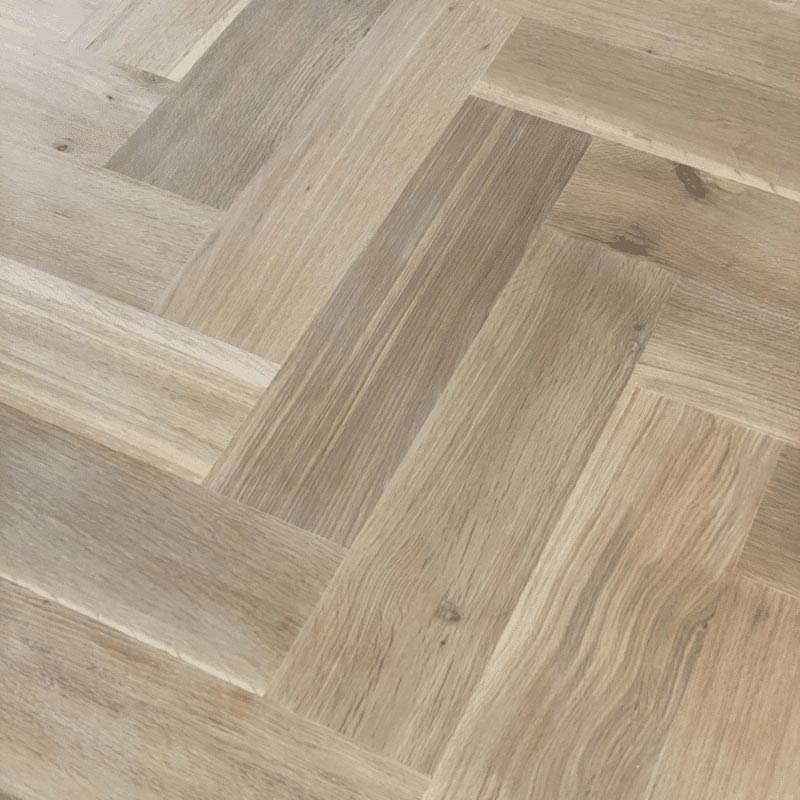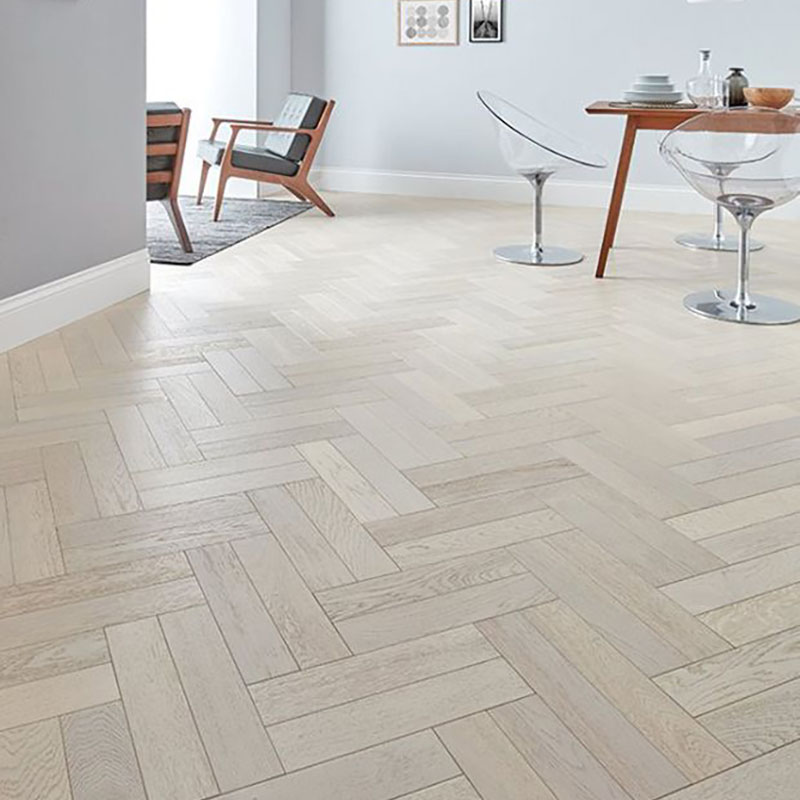Table of Contents
ToggleUnderstanding Herringbone Engineered Wood Floors
Herringbone patterns are a classic and elegant flooring design characterized by a distinctive zigzag arrangement of rectangular wood pieces. By arranging wood planks at a 90-degree angle to one another, the herringbone layout produces an eye-catching, interconnecting motif.
Herringbone patterns add a sense of movement and sophistication to any space. The intricate design can make a room feel more dynamic and spacious, and it has been a popular choice in both traditional and contemporary interiors for centuries. This pattern’s versatility allows it to complement various decor styles, from classic to modern.

Advantages of Engineered Wood Flooring
Stability: Engineered wood flooring’s multi-layered construction reduces natural wood expansion and contraction, offering greater stability than solid wood flooring. This stability is particularly important for herringbone patterns, as the intricate layout requires precise installation and consistent alignment.
Durability: Because of its extreme durability, engineered wood flooring is resistant to daily wear and tear and heavy foot traffic. The top hardwood veneer provides the same timeless beauty and warmth as solid wood, while the core layers add strength and resistance to damage. Because of their strength, herringbone engineered wood flooring is guaranteed to last for many years while still looking great.
Environmental Benefits: The use of plywood or high-density fiberboard in the core layers reduces the demand for high-quality hardwood, conserving valuable natural resources. Additionally, engineered wood flooring can be manufactured with less waste and more efficient use of materials, further contributing to its sustainability.
Choosing the Right Wood Species for Herringbone Engineered Wood Flooring
To get the appropriate look, feel, and endurance out of your herringbone engineered wood flooring, you need to choose the right wood species. We examine some of the wood species that are most frequently used in engineered wood flooring here, along with important considerations for your decision.
Overview of Wood Species Commonly Used in Engineered Wood Flooring
Oak:
- Grain Patterns: Oak features a prominent, open grain pattern that adds texture and interest to flooring.
- Color Variations: Available in a range of hues from light beige to rich brown, making it versatile for various design styles.
- Hardness and Durability: Oak is a popular hardwood for high-traffic areas because of its endurance and toughness.
Maple:
- Grain Patterns: Maple has a subtle, fine grain pattern that provides a smooth and clean appearance.
- Color Variations: Typically lighter in color, ranging from creamy white to light brown, ideal for bright, contemporary spaces.
- Hardness and Durability: Because of its high hardness, maple provides good resistance to abrasion.
Walnut:
- Grain Patterns: Walnut boasts a straight grain with occasional waves, adding depth and character.
- Color Variations: Known for its rich, dark brown color with purple undertones, adding warmth and elegance.
- Hardness and Durability: While slightly softer than oak and maple, walnut is still durable and suitable for most residential settings.
Cherry:
- Grain Patterns: Cherry wood features a fine, straight grain with occasional curls, giving it a smooth and polished look.
- Color Variations: Starts as a light pinkish-brown and darkens to a rich, reddish-brown over time, offering a unique aging process.
- Hardness and Durability: Cherry is moderately hard, balancing beauty and functionality.
Exotic Woods (e.g., Mahogany, Teak)
- Grain Patterns: Exotic woods often have striking grain patterns that make a bold statement.
- Color Variations: These woods come in a variety of deep, rich colors, from the reddish tones of mahogany to the golden-brown hues of teak.
- Hardness and Durability: Generally, exotic woods are very hard and durable, suitable for both residential and commercial applications.
Characteristics and Benefits of Each Wood Species
- Grain Patterns: The aesthetic value of your herringbone floor can be greatly influenced by the wood species’ grain pattern. Oak’s open grain, maple’s subtle pattern, walnut’s wavy lines, cherry’s fine grain, and the dramatic patterns of exotic woods each offer unique aesthetics.
- Color Variations: The natural color of the wood species will influence the room’s ambiance. Darker woods like walnut may bring warmth and refinement, while lighter woods like maple can help a space feel bigger and brighter.
Considerations for Choosing the Right Wood Species
For a modern look, lighter species like maple or oak are ideal, while darker species like walnut or cherry work well in traditional or luxurious settings.
- Foot Traffic and Usage: High-traffic areas benefit from harder, more durable wood species. Oak and maple are excellent choices for durability, while exotic woods can withstand heavy use with proper maintenance.
- Budget Considerations: Exotic woods and certain premium species can be more expensive. Oak and maple are generally more cost-effective while still offering excellent performance.

Customizing Finishes for Herringbone Floors
Selecting the right finish for your herringbone engineered wood floors is essential to enhance their appearance, protect the surface, and extend their longevity. In addition to providing a layer of defense against deterioration, the finish also affects the flooring’s overall appearance. Comprehending the diverse range of finishes and their attributes will facilitate well-informed decision-making.
Importance of Finishes in Enhancing the Look and Longevity of the Flooring
Herringbone floors’ overall performance and appearance are greatly influenced by their finishes. They provide a protective barrier against scratches, moisture, and other potential damage, ensuring the floors remain beautiful and durable for years. Additionally, the right finish can highlight the natural beauty of the wood, enhance its color, and complement the design of your space.
Types of Finishes Available
Oil-Based Finishes
- Appearance and Sheen Levels: Oil-based finishes tend to give wood floors a rich, warm glow with a slight amber tint.
- Maintenance and Durability: These finishes are durable and relatively easy to maintain. In contrast to other finishes, they can need to be reapplied more frequently and take longer to dry.
- Environmental Impact: High volatile organic compound (VOC) levels seen in oil-based finishes have an adverse effect on indoor air quality and the environment.
Water-Based Finishes
- Appearance and Sheen Levels: Water-based finishes are clear and do not yellow over time, preserving the natural color of the wood. Matte, satin, and gloss treatments are offered for them.
- Maintenance and Durability: These finishes are renowned for being long-lasting and low maintenance, and they dry quickly. They also resist yellowing and provide a long-lasting protective layer.
- Environmental Impact: Because water-based coatings have fewer volatile organic compounds (VOCs), they are a greener choice.
UV-Cured Finishes
- Appearance and Sheen Levels: UV-cured finishes provide a clear, durable coating that enhances the natural beauty of the wood.
- Maintenance and Durability: These finishes cure almost instantly when exposed to UV light, resulting in an extremely durable surface that resists scratches and wear.
- Environmental Impact: UV-cured finishes have minimal VOC emissions, making them an environmentally conscious choice.
Wax Finishes
- Appearance and Sheen Levels: Wax finishes offer a low-sheen, natural look that enhances the wood’s texture and grain. They typically provide a matte to satin finish.
- Maintenance and Durability: While wax finishes can be less durable than other types, they are relatively easy to reapply and repair.
- Environmental Impact: Wax finishes are thought to be more environmentally friendly because they typically have lower VOC levels.
Comparison of Finish Types
| Feature | Oil-Based Finishes | Water-Based Finishes | UV-Cured Finishes | Wax Finishes |
| Appearance | Rich, warm glow with amber tint | Clear, preserves natural wood color | Clear, enhances natural beauty | Natural look, enhances texture and grain |
| Drying Time | Longer drying time | Quick drying | Instant curing with UV light | Moderate drying time |
| Durability | Durable but may require frequent reapplication | Highly durable, long-lasting | Extremely durable, resists scratches | Less durable, requires regular maintenance |
| Maintenance | Requires regular maintenance | Easy to maintain | Minimal maintenance required | Regular reapplication needed |
| Environmental Impact | Higher VOC levels, less eco-friendly | Lower VOC levels, eco-friendly | Minimal VOC emissions, eco-friendly | Lower VOC levels, eco-friendly |
| Application | Easy to apply, requires ventilation | Easy to apply, quick drying | Requires professional application | Easy to apply, frequent reapplication |
| Cost | Moderate | Moderate to high | High | Low to moderate |
Special Finishing Techniques
- Hand-Scraped: With this method, the wood’s surface is physically scraped to give it a rough, rustic look. It adds character and uniqueness to the floors, making each plank look handcrafted.
- Wire-Brushed: Wire-brushing removes the soft wood fibers, leaving a textured surface that highlights the grain pattern. This finish adds a subtle, distressed look while increasing the floor’s durability.
- Distressed: Distressing involves intentionally adding marks, dents, and other imperfections to the wood surface to create an aged, vintage look.
- Smooth: To get a smooth finish, sand the wood until it has a polished, streamlined appearance. This finish gives the wood a sleek, contemporary appearance while enhancing its inherent beauty.
Conclusion
As an herringbone wood flooring manufacturer, we encourage you to explore the various combinations of wood species and finishes to find the perfect match for your space. Whether you prefer the timeless elegance of oak, the modern appeal of maple, the sophisticated warmth of walnut, or the exotic allure of woods like mahogany and teak, there is a perfect combination waiting for you. Special finishing techniques such as hand-scraped, wire-brushed, distressed, and smooth can further customize the look of your herringbone floors, adding character and charm.
For personalized advice and to see samples of our wood species and finishes, we invite you to contact us for a consultation. From choosing the best materials to guaranteeing a faultless installation, our professionals are ready to assist you at every stage.
